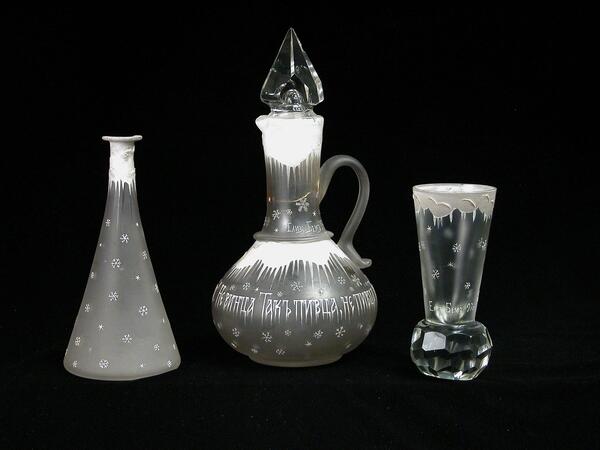Stemmed glasses, pitchers, saucers, glasses, and decanters of the Maltsov factory could be found both in a peasant’s house and on the emperor’s table. The best examples of the products by the Dyatkovo Crystal Factory were displayed at the First Public Exhibition of Russian Manufactures in 1829. The Maltsovs, the factory’s founders, received the exhibition’s main award — the Grand Gold Medal “For Hard Work and Art”. As a result, the factory was entitled to depict the state emblem on its products and the doors of the stores. It was emphasized in the exhibition report that the Dyatkovo Factory was the first in Russia to achieve such a high product quality and that even household items were characterized by a unique glass clarity and exquisite craftsmanship.
The factory’s products have been relevant throughout its history. The 19th century was marked by an unprecedented interest in Russian folk art. During that time, the factory cooperated with the talented Russian illustrator Elizaveta Boehm. The Russian style at its finest was represented by her art. During the first years of the Soviet Union, the craftsmen had to come up with the design of their items on their own. This period was characterized by large decorative vases painted by local artists, the Golubkov brothers, in a poster-like style. During the Great Patriotic War, German troops blew up the factory while retreating. In 1945, a pot furnace was launched in the ruins of the factory. During the transition to peacetime, people once again needed everyday items, including kitchenware, flower vases, souvenirs, and holiday dinnerware sets. For the Dyatkovo Crystal Factory, the first post-war decade was characterized not only by the need to solve technical and technological issues but also by the mass production of art glass.
In the 1960s, the Dyatkovo Crystal Factory welcomed young artists, graduates of the Moscow School of Decorative and Applied Art. In the 1970s–1980s, the factory had a team of talented artists who worked on creating unique large compositions for Soviet and international exhibitions and for the large and bright halls of new buildings. One of the most significant projects at the turn of the 21st century was the design of the crystal monumental iconostasis for the “Burning Bush” icon.
Throughout several centuries, the exquisite skills of craftsmen and artists helped to develop the factory’s unique style — the Maltsov-Dyatkovo crystal — that still enjoys popularity and high demand both in Russian and abroad.
The factory’s products have been relevant throughout its history. The 19th century was marked by an unprecedented interest in Russian folk art. During that time, the factory cooperated with the talented Russian illustrator Elizaveta Boehm. The Russian style at its finest was represented by her art. During the first years of the Soviet Union, the craftsmen had to come up with the design of their items on their own. This period was characterized by large decorative vases painted by local artists, the Golubkov brothers, in a poster-like style. During the Great Patriotic War, German troops blew up the factory while retreating. In 1945, a pot furnace was launched in the ruins of the factory. During the transition to peacetime, people once again needed everyday items, including kitchenware, flower vases, souvenirs, and holiday dinnerware sets. For the Dyatkovo Crystal Factory, the first post-war decade was characterized not only by the need to solve technical and technological issues but also by the mass production of art glass.
In the 1960s, the Dyatkovo Crystal Factory welcomed young artists, graduates of the Moscow School of Decorative and Applied Art. In the 1970s–1980s, the factory had a team of talented artists who worked on creating unique large compositions for Soviet and international exhibitions and for the large and bright halls of new buildings. One of the most significant projects at the turn of the 21st century was the design of the crystal monumental iconostasis for the “Burning Bush” icon.
Throughout several centuries, the exquisite skills of craftsmen and artists helped to develop the factory’s unique style — the Maltsov-Dyatkovo crystal — that still enjoys popularity and high demand both in Russian and abroad.
Exhibits are marked with AR stickers for identification purposes.

